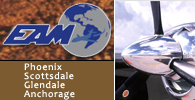My first transatlantic crossing was in April 1974 in a King Air C90. The short story: I was in the back of the plane, ferry pilot, short days, icing, wind, and aurora borealis. My second crossing was in August 1987 in a Piper Cheyenne I from Texas all the way to Geneva, Switzerland. Not a single cloud along the way and the longest leg ever in a Cheyenne I—Reykjavik to Geneva nonstop in 6 hours 42 minutes. We still had enough fuel at altitude to reach Rome, but the tanks would be dry. Fortunately, none of the fuel pumps lit up during our descent and landing at Geneva.
I had to wait until this past month, August 2018, to cross the Atlantic on the Azores route that was used in the early days of commercial transatlantic flights in piston aircraft.
I am escorting Air Journey to Africa with a total of six airplanes. Three began the journey in the U.S. and the remaining three joined in Europe. The three coming from the U.S. have HF equipment, which prompted the idea of crossing via the Azores.
The first leg was to St. John’s, Newfoundland, Canada, on August 25, to rendezvous with the U.S. participants. I had the opportunity to fly a Cessna CJ3+ Citation from Tampa nonstop all the way to Newfoundland, more than 1,900 nautical miles, with a slight tailwind at Flight Level 450. At engine shutdown we still were showing 890 pounds of fuel aboard after doing the full approach into sunny St. John’s.
We did the next day’s departure briefing that same evening, and then the next day launched on our route to Ponta Delgada in the Azores.
On the map the flight looks pretty impressive—only the color blue of the water between the destinations. The total distance from St. John’s to Ponta Delgada is 1,340 nautical miles, which is a pretty short distance for a well-equipped CJ3. That gave us plenty of fuel on arrival and also the option to land at one of the other Azores islands if need be.
The route itself is pretty straightforward. After departing St. John’s, Gander Oceanic clears us to Flight Level 450 with only one restriction—to be at FL450 by West 050, which is about 110 nautical miles from departure. That can be accomplished with a CJ3+ if ISA temperature is within acceptable range, which was the case on that day. We were then requested to be above FL430 by the West 050 border, which we accomplished with no sweat.
The reason for this request is that when you look at the North Atlantic crossing using an application such as Foreflight, you will see that the tracks used by airlines coming from Europe to the U.S. vary as far north as the middle of Greenland and as far south as the northern part of the U.S. The tracks are based on the dominant wind in order to give the most efficient route for the airliners. So, our departure out of St. John’s definitely has to cross the tracks, and since we are still under radar control that makes that climb a lot easier.
Talking to Gander on the HF radio was pretty easy. It is very similar to a VHF communication. We were given two frequencies, the main one and a secondary in case we lost communication on the first. We were asked to report at the next crossing—West 050—and also, strangely enough, they gave us a backup VHF frequency based on an oil platform somewhere below us.
At West 050 we were put in contact with New York Oceanic, one communication only, again confirming the primary and secondary frequency and telling us to contact the Santa Maria Oceanic HF radio at position West 040, which we did.
Our Santa Maria Oceanic HF controller gave us a backup VHF radio frequency and asked us to switch to it. While HF is mandatory to cross the Atlantic on this routing, there is substantial VHF backup along the way. However, Oceanic controllers will not accept any communication using Iridium satellite telephone.
The arrival into Ponta Delgada is straightforward. Since most of the islands are volcanic, they will request that you do the full ILS approach to Runway 30 or, if the wind is out of the east, then the full RNAV 12 approach.
Fuel in Ponta Delgada was only $4.84 a gallon and the only fee by the agent was around $500. Service was easygoing and efficient, and we even got access back to one of the airplanes during our three days on the island.
With the nice weather and a little bit of tailwind we enjoyed an uneventful three-plus-hour flight with good communication along the way and plenty of reserve upon landing. That’s where I finally realized that the CJ3+ is the ideal aircraft to cross the Atlantic nonstop. Believe it or not, after our takeoff from St. John’s and upon reaching our cruising altitude of FL450 and getting the speed stabilized at Mach 0.72, the G3000 was showing that we had enough fuel to cross over Spain and reach the island of Mallorca. Amazing!
The trip also is easy on the body because there is only 1.5 hours difference in times zones between the east coast of the U.S. and St. John’s, then only 2.5 hours from St. John’s to the Azores, and then the remaining two hours when you go to mainland Spain. So, for next year’s transatlantic crossing to Africa, look at Air Journey offering for the first time a nonstop crossing of the Atlantic to Europe.
Air Journey founder Thierry Pouille has visited 172 countries and landed in more than 95 in his or Air Journey participants airplanes.








